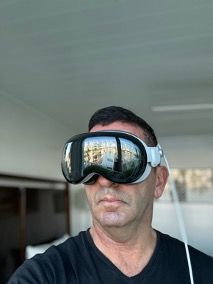What AR (Augmented Reality) & Apple Vision Pro Could Mean to Health & Life Sciences Sector Navigating the New Reality
EVERSANA's chief innovation discusses his experience with Apple's new device and how he thinks it might impact the life sciences industry.
Faruk Capan, chief innovation officer at EVERSANA, tries on the Apple Vision Pro.

In the ever-evolving landscape of augmented reality (AR), Apple's recent launch of the Apple Vision Pro has undeniably set new benchmarks. As someone who has dipped his toes into the immersive world of AR across various devices, my initial experiences with the Apple Vision Pro have been met with a balanced mix of anticipation and skepticism.
So, what has this experience been like and what might this type of product mean to the healthcare and life sciences sector? Here’s my take.
A Leap Towards New AR Technology
From the moment I used Apple Vision Pro, it was clear that Apple had taken AR to a level not previously seen in other goggles. The fluidity with which digital elements blended into the physical world was nothing short of revolutionary. Unlike its predecessors, Apple Vision Pro offered a seamless integration of virtual and real, hinting at a future where the boundaries between the two realms blur indistinguishably. As a marketer in the healthcare sector, the opportunities to create better-connected experiences – for clinicians, patients and even family members, are unmatched. I can imagine a future and one very soon where you put the goggles on at home and experience not only what a visit to a clinic or hospital will be like but have a complete journey of an experience mapped out for you. But it also comes with several questions.
A Stumbling Block – Affordability and Access
The leap to this technology comes with its own set of hurdles, the most significant being the price. The Vision Pro's cost is prohibitively high for the average consumer, echoing the initial criticisms faced by the original iPhone upon its launch. This price barrier not only limits the device's accessibility but also restricts the potential pool of users and developers, which is crucial for the growth and evolution of its ecosystem.
Like all technologies, prices will come down. But for brands that want to consider tapping into this as an offering from day one, be aware of limited audiences.
Exploring Healthcare Applications
With keen interest, I explored the potential of the Apple Vision Pro within the healthcare settings, an area ripe for innovation yet fraught with challenges. The current state of healthcare applications is admittedly nascent, hindered by a lack of developers and users in this space. Despite these limitations, the promise it holds for transforming patient and healthcare professional education, as well as offering new avenues for mental health interventions, is immense.
The device’s capability to overlay intricate anatomical diagrams over the real world could revolutionize medical education and patient care, making complex concepts more accessible and understandable. Similarly, its use in mental health, through immersive therapeutic environments and simulations, could offer new pathways for treatment that were previously unimaginable.
A Glimpse into the Future
The initial response to the Apple Vision Pro, marked by both awe and critique, mirrors the reception of the original iPhone. It's a reminder that groundbreaking innovations often face skepticism, only to redefine what's possible in hindsight. Apple, with its history of turning initial criticisms into legacies of success, may well be on the cusp of doing so again with Vision Pro.
Despite potential limitations in healthcare applications, the potential for growth and innovation is undeniable. Cost and the current scarcity of specialized applications are significant barriers, yet they also represent an opportunity for developers and healthcare professionals to pioneer new uses that could reshape patient care and medical education.
So, is Apple Vision Pro here to stay? And will it become mainstream in our daily life and work? Not right away, but do not be surprised in just months if you continue to see more and more applications to come to life through the power of AR.
I believe it’s a glimpse into a future where digital and physical realities converge to enhance our lives in ways we're just beginning to imagine.
As developers and users gradually embrace this technology and its true impact, particularly in specialized fields like healthcare, transformation awaits. And as a guy who is first in line when the latest device launches, the anticipation of a new reality is always exciting, but with the evolution of technology comes change and we must embrace it to see its value.
Faruk Capan is the Chief Innovation Officer at EVERSANA and the CEO of EVERSANA INTOUCH. He founded Intouch Group more than 20 years ago and is considered a forward-thinker who has embraced technology throughout his career to bring new solutions to complex challenges facing the industry. Reach him at faruk.capan@eversana.com.
Is Artificial Intelligence a ‘Product’? Products Liability Implications for AI-Based Products
April 10th 2025As the physical products we use evolve to become increasingly complex, traditional products liability frameworks may not always fit to provide remedies for harm that can result from using novel product types.